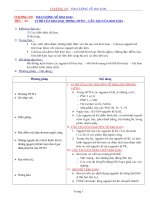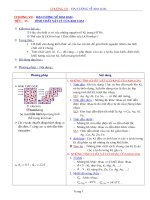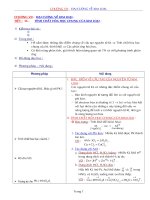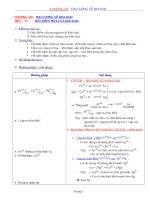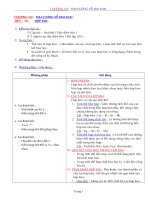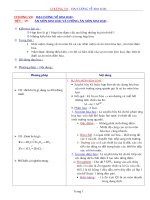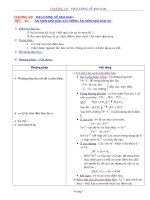61 đại cương về cắn hở
Bạn đang xem bản rút gọn của tài liệu. Xem và tải ngay bản đầy đủ của tài liệu tại đây (26.2 MB, 0 trang )
SSO -Tự học chỉnh nha
sso.
ysem
www
inar
.bsc
.vn
hinh
nha
.com
© Bản quyền thuộc Y company
Tháng 16 - Tuần 2: Đại cương về cắn hở
Cắn hở là một trong những tình trạng lệch lạc răng mặt khó điều trị nhất.
Sự phức tạp của kiểu sai khớp cắn này được cho là do sự kết hợp giữa
các yếu tố về xương, phức hợp răng-xương ổ, chức năng và thói quen.
Điều cần thiết là chẩn đoán chính xác để lập ra một kế hoạch điều trị phù
hợp, và phải kết hợp với cơ học điều trị riêng cho mỗi bệnh nhân để có
được kết quả ổn định.
Cắn hở là đặc điểm của khớp cắn có răng hàm trên và hàm dưới không
tiếp xúc với nhau và không trùm lên nhau theo hướng đứng. Mặc dù kiểu
sai khớp cắn này có thể xảy ra ở một bên hoặt cả hai bên khối răng sau,
nhưng thường gặp ở khối răng trước. Cắn hở phía trước rõ ràng nhất khi
nhìn chính diện, thấy có khoảng trống giữa răng cửa hàm trên và hàm
dưới. Tất nhiên, chẩn đoán lâm sàng của cắn hở phía trước vì thế mà trở
nên khá chủ quan vì nó dựa trên mặt phẳng lượng giá của nha sĩ (H1) và/
hoặc góc mặt phẳng cắn của bệnh nhân. Xét từ mặt phẳng cắn, có thể thấy
hoặc không thấy cắn hở khi nhìn chính diện; mặt phẳng cắn càng dốc, cắn
hở càng không rõ ràng. Cả hai yếu tố này đều ảnh hưởng đến việc xác
định cắn hở trong y văn.
Chịu trách nhiệm chương trình: Y company | BS. Lê Yến Minh | BS. Hồ Mộng Thùy Dương |
© Bản quyền thuộc Y company
Tháng 16 - Tuần 2: Đại cương về cắn hở!
PAGE
2
Tỷ lệ cắn hở răng trước khác nhau giữa các chủng tộc và tuổi răng. Tỷ lệ này phổ
biến ở chủng tộc người Châu Phi, Châu Mỹ (6,6%) hơn là chủng tộc người da
trắng (Cáp-ca) (2,9%) hoặc Tây Ban Nha và Bồ Đào Nha (2,1%). Theo thời gian,
khi trẻ phát triển răng, tỷ lệ cắn hở răng trước tăng lên, vì nó có xu hướng tự
bù
Management
o
trừ trong suốt giai đoạn hàm răng hỗn hợp.
open bite evidenc
instances the skel
by over eruption
makes classificatio
dentoalveolar diffic
of a combination o
It has been rep
related to excessiv
complex, especially
Conversely, dental
reduced incisor de
The difference bet
Fig.hở
8-1
an mặt
anterior
open
bitenhau.
from Không
different
planes.
No phía trước khi
H1: Đánh giá cắn
phíaEvaluation
trước từofcác
phẳng
khác
thấy
cắn hở
anterior open bite is evident from the upper most view. The lower most
nhìn từ trên xuống.
thấp an
hơn
phản ánh
toànbitecảnh
hở mà
thấyview.
được khi nhìn từ
viewGóc
anglenhìn
reflects
extensive
open
not cắn
evident
fromkhông
the top
trên cao xuống. Mức
độ rõ ràng
của cắnofhở
thuộc
độ dốc
phẳng ofcắn và/hoặc mặt
The apparent
magnitude
thephụ
open
bite vào
depends
on của
the mặt
steepness
phẳng quan sát. the occlusal plane and/or the plane of evaluation.
Chịu trách nhiệm chương trình: Y company | BS. Lê Yến Minh | BS. Hồ Mộng Thùy Dương |
© Bản quyền thuộc Y company
Tháng 16 - TuầnFig.
2: 8-1
ĐạiEvaluation
cương of
vềancắn
hở
open bite from different planes. No
anterior
PAGE
3
anterior open bite is evident from the upper most view. The lower most
view angle reflects an extensive open bite not evident from the top view.
The apparent magnitude of the open bite depends on the steepness of
the occlusal plane and/or the plane of evaluation.
B
Fig. 8-3 A Excessive ve
common characteristic of
Fig. 8-2
A large interlabial gap (>3 mm) is the most significant soft
H2: Khoảng cách giữa
hai môi
rất lớn (>3mm) là đặc điểm mô mềm có giá trị nhất của cắn
hở do
anterior dentoalveolar he
tissue characteristic of a skeletal open bite.
xương.
Mặc dù nói đến cắn hở thường là nói đến đến sai khớp cắn do răng, nhưng cũng
có thể là kết quả của sự bất cân xứng răng hoặc xương, hoặc cả hai. Những
thuật ngữ như cắn hở xương, tăng trưởng hướng đứng, phân kỳ quá mức và
kiểu mặt dài được sử dụng để mô tả cắn hở, có thể bị gây ra, ít nhất là có sự
tham gia, bởi một vấn đề về xương.
Chịu trách nhiệm chương trình: Y company | BS. Lê Yến Minh | BS. Hồ Mộng Thùy Dương |
© Bản quyền thuộc Y company
Tháng 16 - Tuần 2: Đại cương về cắn hở!
PAGE
4
Hầu hết những đặc điểm xương và răng thường gặp ở bệnh nhân cắn hở được
Bjork mô tả đầu tiên. Bản mô tả này thảo luận về những đặc điểm hình thái học
có liên quan đến sự xoay hàm dưới xuống dưới và ra sau trong suốt quá trình
tăng trưởng. Những đặc điểm về xương và răng bao gồm: lồi cầu nghiêng xa,
thân xương hàm dưới ngắn, antegonial notching (vết lõm ở bờ dưới XHD, xuất
hiện đột ngột ngay phía trước góc hàm, gần chỗ bám của các cơ nhai), góc hàm
tù (mở), xương hàm trên dài quá mức, ống thần kinh hàm dưới thẳng, symphisis
mỏng và dài, chiều cao mặt trước dài, chiều cao mặt sau ngắn, mặt phẳng hàm
dưới dốc, mặt phẳng cắn phân kỳ, góc răng cửa và răng cối nhọn, mặt phẳng
khẩu cái nghiêng lên trên về phía trước, và trồi răng cối. Trong tất cả những đặc
điểm này, độ dốc của mặt phẳng hàm dưới được coi như là điểm mốc trên xương
có liên quan với cắn hở răng trước.
Xét về đặc điểm mô mềm, hầu hết đều ngang mức với các điểm tương ứng của
mô cứng (chiều cao tầng mặt dưới dài, mặt phẳng hàm dưới dốc, chiều cao tầng
mặt sau ngắn). Thêm vào đó, khám trên lâm sàng thấy khoảng cách giữa hai môi
ở bệnh nhân cắn hở xương thường lớn.
Mặc dù những đặc điểm về xương được kể ra ở trên có liên quan với cắn hở
răng trước, nhưng chỉ 10% bệnh nhân có những đặc điểm này có cắn hở răng
trước rõ ràng với dấu hiệu overbite (-). Trong rất nhiều trường hợp, cắn hở xương
được ngụy trang do răng cửa mọc dài quá mức. Điều này gây nhiều khó khăn
cho việc phân loại cắn hở do xương hàm hay do răng - xương ổ răng . Thường
thì sai khớp cắn kiểu này là kết quả của sự kết hợp cả 2 yếu tố.
Y văn ghi rằng cắn hở xương thường có liên quan với tăng trưởng hướng đứng
quá mức của phức hợp răng-xương ổ răng, đặc biệt ở vùng răng cối phía sau
(H3A). Ngược lại, cắn hở răng phía trước ban đầu là do giảm chiều cao răngxương ổ răng vùng răng cửa (H3B). Sự khác nhau giữa hai kiểu cắn hở này cũng
thể hiện trên mặt phẳng cắn. Sai khớp cắn do xương thường chỉ chạm cắn ở
răng cối, mặt phẳng cắn phân kỳ phía trước (H4A), trong khi mặt phẳng cắn ở
Chịu trách nhiệm chương trình: Y company | BS. Lê Yến Minh | BS. Hồ Mộng Thùy Dương |
open bite evidenced as a negative overbite. 6 In many
instances the skeletal open bite has been camouflaged
by over
eruption of
teeth. This very issue
Management
of the
Openanterior
Bite Malocclusion
©157
Bản quyền thuộc Y company
makes classification of an open bite as either skeletal or
PAGE
dentoalveolar
difficult.
Tháng 16 - Tuần 2: Đại
cương về
cắnOften
hở this malocclusion is the result
6
of aopen
combination
of both as
factors.
bite evidenced
a negative overbite. In many
It
has beenthereported
skeletal
openbeen
bitescamouflaged
are often
instances
skeletalthat
open
bite has
of the This
dentoalveolar
related
to excessive
growth teeth.
by over
eruption vertical
of the anterior
very issue
complex,
in theofposterior
region
(Fig.
8-3A).or
makes especially
classification
an openmolar
bite as
either
skeletal
Conversely,
dental
anterior
openthis
bites
are primarily
dueresult
to
dentoalveolar
difficult.
Often
malocclusion
is the
reduced
incisor dentoalveolar
vertical height (Fig. 8-3B).7
of a combination
of both factors.
trường hợp cắn hở do
ổ răng
thường
phân
kỳ often
từis răng cối thứ nhất ra
It has beenbetween
reported
that two
skeletal
bites bites
are
Therăng-xương
difference
these
typesopen
of
open
related to excessive vertical growth of the dentoalveolar
phía trước (H4B).
complex, especially in the posterior molar region (Fig. 8-3A).
Conversely, dental anterior open bites are primarily due to
reduced incisor dentoalveolar vertical height (Fig. 8-3B).7
The difference between these two types of open bites is
•
!
n of an anterior open bite from different planes. No
evident from the upper most view. The lower most
n extensive open bite not evident from the top view.
tude of the open bite depends on the steepness of
nd/or the plane of evaluation.
uation of an anterior open bite from different planes. No
ite is evident from the upper most view. The lower most
ects an extensive open bite not evident from the top view.
magnitude of the open bite depends on the steepness of
ane and/or the plane of evaluation.
5
H3A: Chiều cao khối răng sau quá mức là đặc điểm chung của những bệnh nhân cắn hở phía trước
do xương.
dentoalveolar
height
dentoalveolar
height
Reduced dentoalveolar
height
B
Reduced dentoalveolar
nterlabial gap (>3 mm) is the most significant soft
of a skeletal open bite.
rge interlabial gap (>3 H3B:
mm) is theGiảm
most significant
chiều soft
cao
eristic of a skeletal open bite.
height is a
Fig. 8-3 A Excessive vertical height of the buccal segments
common characteristic of skeletal anterior open bite patients. B Reduced
anterior dentoalveolar height characterizes a dental anterior open bite.
B
Fig. 8-3 A Excessive vertical height of the buccal segments is a
common characteristic
of skeletal
anterior
bite patients.
B Reduced
răng-xương
ổ răng phía
trước
đặcopentrưng
cho cắn
hở do răng
anterior dentoalveolar height characterizes a dental anterior open bite.
Chịu trách nhiệm chương trình: Y company | BS. Lê Yến Minh | BS. Hồ Mộng Thùy Dương |
Fig. 8-5 An
158
•
mandibular p
Biomechanics and Esthetic Strategies in Clinical Orthodontics
© Bản quyền thuộc Y company
Tháng
16 - generally
Tuần has
2: Đại
cương
malocclusion
occlusal
contacts về
only cắn
at the hở!
also reflected in the occlusal planes. The skeletal type of
PAGE
6
molar level, with both occlusal planes diverging anteriorly
(Fig. 8-4A), while the occlusal planes in the dentoalveolar
open bite usually diverge from the first premolar forward
(Fig. 8-48).8
Even though the skeletal and dental characteristics of
an anterior open bite are specifically related to the vertical
dimension, these are also reflected in the anteroposterior
dimension.
that are ro
projection
less comm
may presen
The etiolog
of genetic
componen
the enviro
malocclusi
Fig. 8-5 Anterior open bite may also be found in patients with
mandibular prognathism and Class III occlusion.
dimension. Open bite patients commonly have mandibles
that are rotated down and back, with poor anterior chin
projection and skeletal Class IT patterns. However, although
less common, some patients with skeletal anterior open bite
may present with a Class III pattern (Fig. 8-5)Y II
The etiology of any type of malocclusion is a combination
Fig.
8-4 Occlusal
characteristicsfactors.
of skeletal
and dental
bites.
of
genetic
and environmental
Although
theopen
genetic
Occlusal planes
generallyopen
diverge
fromis the
molar
anteriorly in
component
of A
skeletal
bites
notfirst
well
understood,
skeletal
open bites andfactors
B generally
the first premolars
the
environmental
thatdiverge
may from
contribute
to this
anteriorly in dental
bites.
malocclusion
haveopen
been
reported extensively.
H4: Những đặc điểm khớp cắn của cắn hở răng và xương. Mặt phẳng cắn A thường phân kỳ từ
răng 6 ra trước trong trường hợp cắn hở xương và B thường phân kỳ từ răng 4 ra trước trong cắn
hở răng.
A major etiologic factor that reportedly contributes to
open bites is an imbalance between the tongue and the
perioral musculature. 12 Various habits such as tongue thrust,
thumb and finger sucking, as well as anatomic conditions
such as macroglossia have been reported as causative
factors. These factors contribute to the development of
an open bite malocclusion by adversely affecting the
development of the anterior dentoalveolar complex and
inhibiting the normal eruption of teeth. 13 Concurrent flaring
of the upper anterior teeth is also observed as a result of
the tongue or finger force against the lingual surface of the
incisors. 14
The clinician should carefully consider the role that the
tongue plays in the etiology of open bite. Both the function
and anatomy of the tongue must be evaluated. From an
anatomic point of view, a large tongue (macroglossia) can
be responsible for splaying the anterior teeth, and thus
causing an open bite. Unfortunately, it is difficult to
Thậm chí, mặc dù những đặc điểm về xương và răng của cắn hở phía trước có
liên quan đặc biệt đến kích thước dọc, nhưng những đặc điểm này cũng được
phản ánh ở mặt phẳng trước sau. Bệnh nhân cắn hở thường có hàm dưới xoay
xuống dưới và ra sau, cằm nhô ít và kiểu xương hạng II. Tuy nhiên, dù không phổ
biến, nhưng vẫn có một vài bệnh nhân cắn hở xương phía trước có kiểu Hạng III
(H5).
Fig. 8-4 Occlusal characteristics of skeletal and dental open bites.
Occlusal planes A generally diverge from the first molar anteriorly in
skeletal open bites and B generally diverge from the first premolars
anteriorly in dental open bites.
Chịu trách nhiệm chương trình: Y company | BS. Lê Yến Minh | BS. Hồ Mộng Thùy Dương |
A major
open bites
perioral mu
thumb and
such as m
factors. Th
an open b
developme
inhibiting t
of the upp
the tongue
incisors. 14
The clin
tongue pla
and anatom
anatomic p
be respons
causing an
© Bản quyền thuộc Y company
Tháng 16 - Tuần 2: Đại cương về cắn hở!
PAGE
iomechanics and Esthetic Strategies in Clinical Orthodontics
the occlusal planes. The skeletal type of
nerally has occlusal contacts only at the
h both occlusal planes diverging anteriorly
le the occlusal planes in the dentoalveolar
y diverge from the first premolar forward
the skeletal and dental characteristics of
bite are specifically related to the vertical
e are also reflected in the anteroposterior
Fig. 8-5 Anterior open bite may also be found in patients with
mandibular
prognathism
and đưa
Class IIIhàm
occlusion.
H5: Có thể thấy cắn hở phía
trước
cùng với
dưới ra trước và khớp cắn hạng III.
dimension. Open bite patients commonly have mandibles
that are rotated down and back, with poor anterior chin
projection and skeletal Class IT patterns. However, although
less common, some patients with skeletal anterior open bite
may present with a Class III pattern (Fig. 8-5)Y II
The etiology of any type of malocclusion is a combination
of genetic and environmental factors. Although the genetic
component of skeletal open bites is not well understood,
the environmental factors that may contribute to this
malocclusion have been reported extensively.
A major etiologic factor that reportedly contributes to
open bites is an imbalance between the tongue and the
perioral musculature. 12 Various habits such as tongue thrust,
thumb and finger sucking, as well as anatomic conditions
such as macroglossia have been reported as causative
factors. These factors contribute to the development of
an open bite malocclusion by adversely affecting the
development of the anterior dentoalveolar complex and
inhibiting the normal eruption of teeth. 13 Concurrent flaring
of the upper anterior teeth is also observed as a result of
the tongue or finger force against the lingual surface of the
incisors. 14
The clinician should carefully consider the role that the
tongue plays in the etiology of open bite. Both the function
characteristics of skeletal and dental open bites.
and anatomy of the tongue must be evaluated. From an
Chịu trách
trình: Y company | BS. Lê Yến Minh | BS. Hồ Mộng Thùy Dương |
enerally diverge from the first molar anteriorly
in nhiệm chương
anatomic point of view, a large tongue (macroglossia) can
nd B generally diverge from the first premolars
be responsible for splaying the anterior teeth, and thus
pen bites.
causing an open bite. Unfortunately, it is difficult to
7



